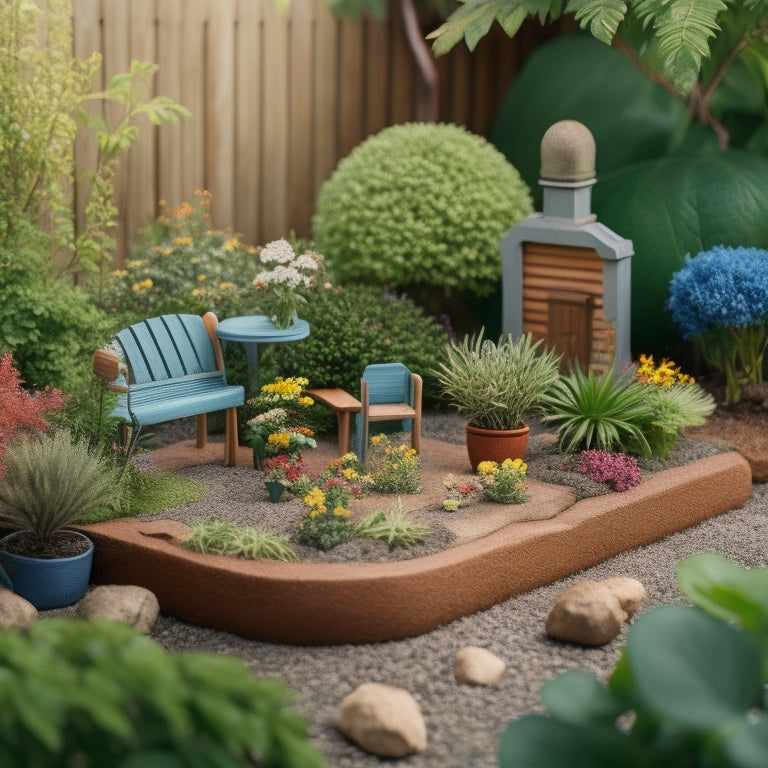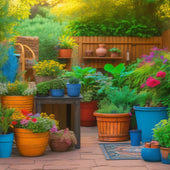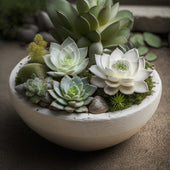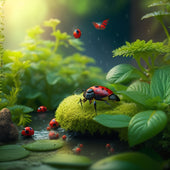
Budget-Friendly Planters for Small Garden Spaces
Share
Transform your small outdoor space into a vibrant oasis on a budget! Repurpose cinder blocks, vintage boots, old pallets, and worn-out tires into unique planters that add texture and character to your garden. Upcycle plastic bottles into self-watering planters or create mini gardens in repurposed containers. For space-saving solutions, opt for compact, vertical, or wall-mounted planters that maximize space while showcasing your plants. With a little creativity, you can craft one-of-a-kind planters that not only save you money but also reflect your personal style - and there are plenty of innovative ideas waiting to be discovered to take your small garden space to the next level.
Key Takeaways
• Repurpose cinder blocks, vintage boots, or old pallets into unique planters to add texture and character to small gardens.
• Upcycle plastic bottles into self-watering planters or transform metal colanders into whimsical hanging planters for a budget-friendly approach.
• Use compact planters, vertical gardening solutions, and wall-mounted planters to maximize space in small gardens.
• Opt for inexpensive terra cotta pots, wooden crates, or DIY projects to create functional and affordable planters.
• Get creative with DIY projects to upcycle materials, reduce costs, and add a personal touch to small garden spaces.
Creative Cinder Block Ideas
Transform your small garden into a vibrant oasis by repurposing cinder blocks into unique planters that add texture and visual interest to your outdoor space. You'll be amazed at how these humble blocks can be transformed into stunning pieces of cinder block art.
For a modern twist, try stacking cinder blocks to create a vertical gardening system, perfect for showcasing trailing plants or herbs. You can also use them to create a living wall, adding a touch of greenery to even the smallest of spaces.
To add some personality to your planters, try painting or staining the cinder blocks in bold, bright colors. You can also add a decorative touch by incorporating small tiles, pebbles, or even seashells into the design.
For a more rustic look, leave the blocks in their natural state and let the plants take center stage. Whatever your style, repurposing cinder blocks is a budget-friendly way to add some creativity and flair to your small garden.
With a little imagination, you can turn these ordinary blocks into extraordinary planters that will make your outdoor space truly special.
Small Space Planter Solutions
In small gardens, every inch counts, and that's where compact planters come in, allowing you to maximize space while still showcasing your favorite plants and flowers.
You can create a lush oasis in even the tiniest of spaces by opting for vertical gardening solutions. Consider installing a trellis or an arbor to train vining plants like ivy or clematis to grow upwards, freeing up floor space for other plants. Alternatively, use wall-mounted planters or pocket planters to add depth and visual interest to your garden's perimeter.
When it comes to container gardening, choose planters that are narrow and tall rather than short and wide. This will help you make the most of your available space while still providing ample room for your plants to grow.
Don't be afraid to get creative with your planter placement, either – try grouping smaller planters together to create a visually appealing display or using hanging baskets to add a touch of whimsy to your garden.
Budget-Friendly Planter Options
With a little creativity, you can find or repurpose budget-friendly planters that add charm to your small garden without breaking the bank. Look for affordable materials like wooden crates, plastic containers, or terra cotta pots that can be transformed into unique planters. You can also get creative with vertical gardening by using trellises, arbors, or wall-mounted planters to maximize space.
Here are some budget-friendly planter options to evaluate:
| Planter Option | Description |
|---|---|
| Wooden Crates | Upcycle old crates into rustic planters with a personal touch |
| Plastic Containers | Repurpose plastic containers like buckets or tubs into colorful planters |
| Terra Cotta Pots | Inexpensive and versatile, terra cotta pots add a touch of elegance |
| Vertical Planters | Make the most of your space with wall-mounted or trellis planters |
Cinder Block Planter Design
As you start designing your cinder block planter, you'll want to contemplate the block pattern ideas that will visually anchor your small garden.
You'll appreciate how easy it's to assemble these planters, thanks to their straightforward DIY construction.
Block Pattern Ideas
You can create visually appealing block pattern ideas by arranging cinder blocks in a staggered formation, alternating between solid and hollow blocks to add depth and texture to your small garden planter. This unique arrangement allows you to experiment with different block pattern styles, creating a one-of-a-kind design that reflects your personal taste.
Some inspiring ideas to get you started include:
-
Alternating Columns: Create a striking visual effect by alternating solid and hollow blocks in vertical columns, adding a touch of modernity to your planter.
-
Chevron Pattern: Arrange blocks in a chevron pattern, where each row is offset from the previous one, creating a dynamic and eye-catching design.
-
Stacked Blocks: Stack solid and hollow blocks in a staggered formation, creating a sense of movement and energy in your small garden planter.
Easy DIY Assembly
To bring your block pattern ideas to life, start by preparing the site for your cinder block planter, clearing the area of any debris and leveling the ground to confirm a stable foundation.
Next, lay down a layer of landscape fabric to prevent weeds from growing up through the planter.
Now, begin constructing your planter by stacking the cinder blocks, starting from the bottom and working your way up. Make sure to stagger the blocks to create a sturdy structure. As you build, leave space between the blocks for drainage and aeration.
For a vertical gardening effect, stack the blocks higher, creating a tiered planter. Alternatively, you can keep it simple and create a single-level container gardening setup.
Use a level to confirm the blocks are straight and even.
Finally, fill the planter with a mix of potting soil and compost, and you're ready to plant your favorite flowers, herbs, or vegetables.
With these easy DIY assembly steps, you'll be enjoying your cinder block planter in no time!
Space-Saving Design Tips
By strategically placing your cinder block planter in a corner or against a wall, you can maximize space in your small garden while creating a beautiful, functional display. This space-saving design tip is perfect for small gardens, allowing you to make the most of your available space.
Here are some ways to optimize your cinder block planter design:
-
Stack them high: Create a vertical gardening masterpiece by stacking multiple cinder block planters on top of each other. This won't only save space but also add visual interest to your garden.
-
Use the wall: Attach your cinder block planter to a wall or fence, making the most of your garden's vertical space. This is a great way to incorporate container gardening into your small garden.
-
Create a corner oasis: Place your cinder block planter in a corner, adding a touch of greenery to an often-neglected area. This will create a cozy, inviting atmosphere in your small garden.
Upcycled Garden Decor Inspiration
Vintage boots, old pallets, and worn-out tires transform into charming planters, injecting a touch of whimsy and personality into your small garden. You can reimagine these upcycled materials as unique planters that add character to your outdoor space.
Imagine a distressed wooden pallet turned into a vertical planter, showcasing a lush green wall of herbs or succulents. Or, picture a pair of vintage boots filled with colorful flowers, adding a playful touch to your garden path.
Upcycled materials offer endless possibilities for creating one-of-a-kind planters that reflect your personal style and garden aesthetics. By repurposing old items, you're not only reducing waste but also adding a touch of creativity to your garden design.
You can paint, stain, or decoupage your upcycled planters to match your garden's color scheme and theme. With a little imagination, you can turn ordinary objects into extraordinary planters that elevate your small garden's charm and visual appeal.
DIY Planter Project Ideas
Transform empty plastic bottles into self-watering planters that will add a futuristic touch to your small garden, complete with a built-in water reservoir and a sleek, modern design. You'll be amazed at how easily you can create a mini oasis in even the smallest of spaces.
Here are some DIY planter project ideas to get you started:
-
Create a vertical herb garden by stacking wooden crates or old pallets and filling them with a mix of potting soil and herbs like basil, mint, and rosemary.
-
Upcycle an old window into a mini greenhouse planter, perfect for starting seeds or showcasing a small succulent arrangement.
-
Turn a metal colander into a hanging planter, adding a whimsical touch to your porch or patio with a trailing vine or flowering plant.
With these DIY projects, you'll be able to add a personal touch to your small garden while also maximizing space. Plus, you'll have the satisfaction of knowing you created something beautiful and functional with your own hands.
Frequently Asked Questions
Can I Use Planters Made of Plastic in a Small Garden?
You're wondering if plastic planters are a good fit for your small garden. The answer is, it depends.
While plastic planters can be a convenient option, they mightn't be the most eco-friendly choice.
Consider the planter aesthetics you're aiming for - do you want a sleek, modern look or a more natural vibe?
If you opt for plastic, choose planters with a natural finish to blend with your garden's surroundings.
How Often Should I Water Plants in Small Planters?
When it comes to watering plants in small planters, you'll want to strike the right balance.
Check the soil daily, and water only when the top inch feels dry. You're aiming for a moisture retention sweet spot, where the soil's not too soggy or parched.
Watering frequency will depend on factors like climate, pot size, and plant type. Be prepared to adjust your schedule as needed, and keep an eye out for signs of overwatering, like yellowing leaves or waterlogged soil.
Are Self-Watering Planters Suitable for Small Gardens?
You're wondering if self-watering planters are suitable for your small garden.
On one hand, they're perfect for busy days when you forget to water; on the other, they can be bulky.
But, the benefits outweigh the drawbacks.
Self-watering planters reduce overwatering, and their built-in reservoirs guarantee plants receive the right amount of moisture.
Plus, they come in compact sizes, fitting seamlessly into small gardens.
With self-watering planters, you'll enjoy healthy plants and more free time, minus the guilt of neglect.
Can I Grow Vegetables in Small Planters and Containers?
You can definitely grow veggies in small planters and containers!
Start by choosing compact vegetable varieties that thrive in container gardening, such as cherry tomatoes, leafy greens, or herbs.
Select a planter that's at least 5-7 gallons to provide enough room for roots to grow. Make sure it has good drainage holes to prevent waterlogged soil.
With proper care, you'll be harvesting fresh produce from your mini garden in no time!
Do Planters Need Drainage Holes in the Bottom?
You're probably thinking, 'Who needs drainage holes when you can just add more soil?' But trust us, you don't want waterlogged plants.
You see, without proper drainage, roots start to rot, and your veggies will suffer.
Look for planters with built-in drainage holes or opt for materials like terra cotta or ceramic that allow for natural airflow.
If your planter doesn't have holes, create your own drainage solutions, like adding a layer of rocks or broken pottery at the bottom.
You're in control, and your plants will thank you!
Conclusion
As you step into your petite garden, surrounded by lush greenery and vibrant blooms, you're transported to a whimsical world where Alice's curiosity meets the ingenuity of a modern-day MacGyver.
With these budget-friendly planter ideas, you've mastered the art of maximizing space while minimizing costs.
Your tiny oasis is now a reflection of your creativity, where cinder blocks, upcycled treasures, and DIY magic converge to create a charming sanctuary that's truly one-of-a-kind.
Related Posts
-

3 Best DIY Planter Ideas for Backyard Decor
You can elevate your backyard's style and functionality by choosing the right DIY planter ideas. Start with a mix of ...
-

3 Best DIY Planter Ideas for Backyard Decor
You can elevate your backyard's style and functionality by choosing the right DIY planter ideas. Start with a mix of ...
-

3 Best DIY Planter Ideas for Backyard Decor
You can elevate your backyard's style and functionality by choosing the right DIY planter ideas. Start with a mix of ...
-

3 Best DIY Planter Ideas for Backyard Decor
You can elevate your backyard's style and functionality by choosing the right DIY planter ideas. Start with a mix of ...
-

3 Best DIY Planter Ideas for Backyard Decor
You can elevate your backyard's style and functionality by choosing the right DIY planter ideas. Start with a mix of ...
-

3 Best DIY Planter Ideas for Backyard Decor
You can elevate your backyard's style and functionality by choosing the right DIY planter ideas. Start with a mix of ...
-

3 Best DIY Planter Ideas for Backyard Decor
You can elevate your backyard's style and functionality by choosing the right DIY planter ideas. Start with a mix of ...
-

3 Best DIY Planter Ideas for Backyard Decor
You can elevate your backyard's style and functionality by choosing the right DIY planter ideas. Start with a mix of ...
-

3 Best DIY Planter Ideas for Backyard Decor
You can elevate your backyard's style and functionality by choosing the right DIY planter ideas. Start with a mix of ...
-

3 Best DIY Planter Ideas for Backyard Decor
You can elevate your backyard's style and functionality by choosing the right DIY planter ideas. Start with a mix of ...
-

3 Best DIY Planter Ideas for Backyard Decor
You can elevate your backyard's style and functionality by choosing the right DIY planter ideas. Start with a mix of ...
-

3 Best DIY Planter Ideas for Backyard Decor
You can elevate your backyard's style and functionality by choosing the right DIY planter ideas. Start with a mix of ...
-

3 Best DIY Planter Ideas for Backyard Decor
You can elevate your backyard's style and functionality by choosing the right DIY planter ideas. Start with a mix of ...
-

3 Best DIY Planter Ideas for Backyard Decor
You can elevate your backyard's style and functionality by choosing the right DIY planter ideas. Start with a mix of ...
-

What Makes a Great Planter for Succulents
When selecting a great planter for succulents, you'll want to take into account a combination of factors to guarantee...
-

What Makes a Great Planter for Succulents
When selecting a great planter for succulents, you'll want to take into account a combination of factors to guarantee...
-

What Makes a Great Planter for Succulents
When selecting a great planter for succulents, you'll want to take into account a combination of factors to guarantee...
-

What Makes a Great Planter for Succulents
When selecting a great planter for succulents, you'll want to take into account a combination of factors to guarantee...
-

What Makes a Great Planter for Succulents
When selecting a great planter for succulents, you'll want to take into account a combination of factors to guarantee...
-

What Makes a Great Planter for Succulents
When selecting a great planter for succulents, you'll want to take into account a combination of factors to guarantee...
-

What Makes a Great Planter for Succulents
When selecting a great planter for succulents, you'll want to take into account a combination of factors to guarantee...
-

What Makes a Great Planter for Succulents
When selecting a great planter for succulents, you'll want to take into account a combination of factors to guarantee...
-

What Makes a Great Planter for Succulents
When selecting a great planter for succulents, you'll want to take into account a combination of factors to guarantee...
-

What Makes a Great Planter for Succulents
When selecting a great planter for succulents, you'll want to take into account a combination of factors to guarantee...
-

What Makes a Great Planter for Succulents
When selecting a great planter for succulents, you'll want to take into account a combination of factors to guarantee...
-

What Makes a Great Planter for Succulents
When selecting a great planter for succulents, you'll want to take into account a combination of factors to guarantee...
-

What Makes a Great Planter for Succulents
When selecting a great planter for succulents, you'll want to take into account a combination of factors to guarantee...
-

What Makes a Great Planter for Succulents
When selecting a great planter for succulents, you'll want to take into account a combination of factors to guarantee...
-

What Makes a Great Planter for Succulents
When selecting a great planter for succulents, you'll want to take into account a combination of factors to guarantee...
-

What Makes a Great Planter for Succulents
When selecting a great planter for succulents, you'll want to take into account a combination of factors to guarantee...
-

What Makes a Great Planter for Succulents
When selecting a great planter for succulents, you'll want to take into account a combination of factors to guarantee...
-

What Makes a Great Planter for Succulents
When selecting a great planter for succulents, you'll want to take into account a combination of factors to guarantee...
-

What Makes a Great Planter for Succulents
When selecting a great planter for succulents, you'll want to take into account a combination of factors to guarantee...
-

What Makes a Great Planter for Succulents
When selecting a great planter for succulents, you'll want to take into account a combination of factors to guarantee...
-

What Makes a Great Planter for Succulents
When selecting a great planter for succulents, you'll want to take into account a combination of factors to guarantee...
-

What Makes a Great Planter for Succulents
When selecting a great planter for succulents, you'll want to take into account a combination of factors to guarantee...
-

What Makes a Great Planter for Succulents
When selecting a great planter for succulents, you'll want to take into account a combination of factors to guarantee...
-

What Makes a Great Planter for Succulents
When selecting a great planter for succulents, you'll want to take into account a combination of factors to guarantee...
-

10 Essential Tips to Prevent Disease in Vertical Gardens
You're about to discover the essential strategies to protect your vertical garden from disease, ensuring a thriving a...
-

10 Essential Tips to Prevent Disease in Vertical Gardens
You're about to discover the essential strategies to protect your vertical garden from disease, ensuring a thriving a...
-

10 Essential Tips to Prevent Disease in Vertical Gardens
You're about to discover the essential strategies to protect your vertical garden from disease, ensuring a thriving a...
-

10 Essential Tips to Prevent Disease in Vertical Gardens
You're about to discover the essential strategies to protect your vertical garden from disease, ensuring a thriving a...
-

10 Essential Tips to Prevent Disease in Vertical Gardens
You're about to discover the essential strategies to protect your vertical garden from disease, ensuring a thriving a...
-

10 Essential Tips to Prevent Disease in Vertical Gardens
You're about to discover the essential strategies to protect your vertical garden from disease, ensuring a thriving a...
-

10 Essential Tips to Prevent Disease in Vertical Gardens
You're about to discover the essential strategies to protect your vertical garden from disease, ensuring a thriving a...
-

10 Essential Tips to Prevent Disease in Vertical Gardens
You're about to discover the essential strategies to protect your vertical garden from disease, ensuring a thriving a...
-

10 Essential Tips to Prevent Disease in Vertical Gardens
You're about to discover the essential strategies to protect your vertical garden from disease, ensuring a thriving a...
-

10 Essential Tips to Prevent Disease in Vertical Gardens
You're about to discover the essential strategies to protect your vertical garden from disease, ensuring a thriving a...
-

10 Essential Tips to Prevent Disease in Vertical Gardens
You're about to discover the essential strategies to protect your vertical garden from disease, ensuring a thriving a...
-

10 Essential Tips to Prevent Disease in Vertical Gardens
You're about to discover the essential strategies to protect your vertical garden from disease, ensuring a thriving a...
-

10 Essential Tips to Prevent Disease in Vertical Gardens
You're about to discover the essential strategies to protect your vertical garden from disease, ensuring a thriving a...
-

10 Essential Tips to Prevent Disease in Vertical Gardens
You're about to discover the essential strategies to protect your vertical garden from disease, ensuring a thriving a...
-

10 Essential Tips to Prevent Disease in Vertical Gardens
You're about to discover the essential strategies to protect your vertical garden from disease, ensuring a thriving a...
-

10 Essential Tips to Prevent Disease in Vertical Gardens
You're about to discover the essential strategies to protect your vertical garden from disease, ensuring a thriving a...
-

10 Essential Tips to Prevent Disease in Vertical Gardens
You're about to discover the essential strategies to protect your vertical garden from disease, ensuring a thriving a...
-

10 Essential Tips to Prevent Disease in Vertical Gardens
You're about to discover the essential strategies to protect your vertical garden from disease, ensuring a thriving a...
-

10 Essential Tips to Prevent Disease in Vertical Gardens
You're about to discover the essential strategies to protect your vertical garden from disease, ensuring a thriving a...
-

10 Essential Tips to Prevent Disease in Vertical Gardens
You're about to discover the essential strategies to protect your vertical garden from disease, ensuring a thriving a...
-

10 Essential Tips to Prevent Disease in Vertical Gardens
You're about to discover the essential strategies to protect your vertical garden from disease, ensuring a thriving a...
-

10 Essential Tips to Prevent Disease in Vertical Gardens
You're about to discover the essential strategies to protect your vertical garden from disease, ensuring a thriving a...
-

10 Essential Tips to Prevent Disease in Vertical Gardens
You're about to discover the essential strategies to protect your vertical garden from disease, ensuring a thriving a...
-

10 Essential Tips to Prevent Disease in Vertical Gardens
You're about to discover the essential strategies to protect your vertical garden from disease, ensuring a thriving a...
-

10 Essential Tips to Prevent Disease in Vertical Gardens
You're about to discover the essential strategies to protect your vertical garden from disease, ensuring a thriving a...
-

10 Essential Tips to Prevent Disease in Vertical Gardens
You're about to discover the essential strategies to protect your vertical garden from disease, ensuring a thriving a...
-

10 Essential Tips to Prevent Disease in Vertical Gardens
You're about to discover the essential strategies to protect your vertical garden from disease, ensuring a thriving a...
-

10 Essential Tips to Prevent Disease in Vertical Gardens
You're about to discover the essential strategies to protect your vertical garden from disease, ensuring a thriving a...
-

10 Essential Tips to Prevent Disease in Vertical Gardens
You're about to discover the essential strategies to protect your vertical garden from disease, ensuring a thriving a...


